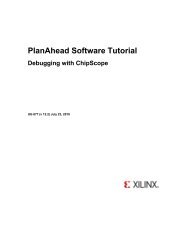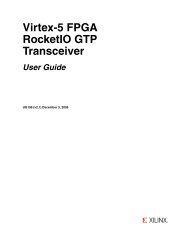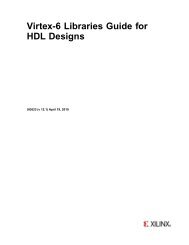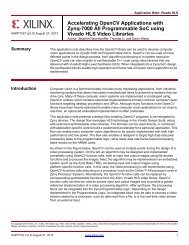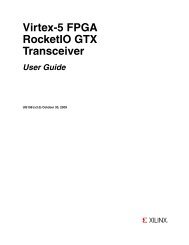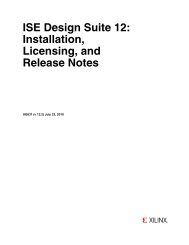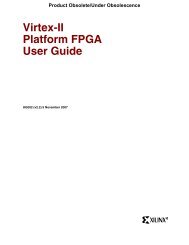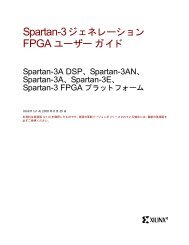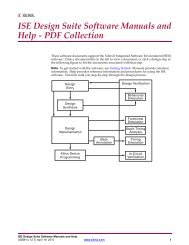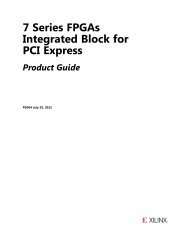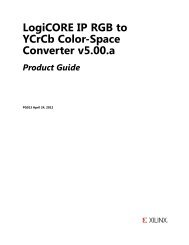Xilinx Partial Reconfiguration User Guide
Xilinx Partial Reconfiguration User Guide
Xilinx Partial Reconfiguration User Guide
Create successful ePaper yourself
Turn your PDF publications into a flip-book with our unique Google optimized e-Paper software.
Chapter 1Introduction<strong>Partial</strong> <strong>Reconfiguration</strong> is the modification of an operating FPGA design by loading apartial configuration file. This guide describes how to create and implement an FPGAdesign that is partially reconfigurable using a modular design technique calledPartitioning. Module instances in the design are translated into partial BIT files whichdefine the new hardware function. Other techniques such as the differencing methoddescribed in the Application Note: Differencing Method for <strong>Partial</strong> <strong>Reconfiguration</strong>(XAPP290) are not covered in this guide. For supplemental material, see Appendix C,Additional Resources.This guide:• Is intended for designers who want to create a <strong>Partial</strong>ly Reconfigurable FPGA design• Assumes familiarity with FPGA design software, particularly <strong>Xilinx</strong> ® ISE ® DesignSuite and the PlanAhead software.• Has been written specifically for ISE Design Suite Release 13.1. This release supports<strong>Partial</strong> <strong>Reconfiguration</strong> for Virtex ® -4, Virtex-5, and Virtex-6 devices only.<strong>Partial</strong> <strong>Reconfiguration</strong> OverviewFPGA technology provides the flexibility of on-site programming and re-programmingwithout going through re-fabrication with a modified design. <strong>Partial</strong> <strong>Reconfiguration</strong> (PR)takes this flexibility one step further, allowing the modification of an operating FPGAdesign by loading a partial configuration file, usually a partial bit file. After a full bit fileconfigures the FPGA, partial BIT files can be downloaded to modify reconfigurable regionsin the FPGA without compromising the integrity of the applications running on thoseparts of the device that are not being reconfigured.Figure 1-1 illustrates the premise behind <strong>Partial</strong> <strong>Reconfiguration</strong>.X-Ref Target - Figure 1-1FPGAReconfigBlock “A”A4.bitA3.bitA2.bitA1.bitX12001Figure 1-1:Basic Premise of <strong>Partial</strong> <strong>Reconfiguration</strong><strong>Partial</strong> <strong>Reconfiguration</strong> <strong>User</strong> <strong>Guide</strong> www.xilinx.com 9UG702 (v13.1) March 1, 2011



